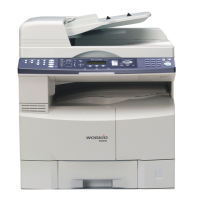141
DP-8032/8025
2008Ver. 1.2
router hop along with the IP Address of each router crossed. If a FQDN (Fully Qualified Domain
Name) is available, it will be displayed as well.
This utility is useful for two diagnostic purposes:
a. To detect whether a particular router is malfunctioning along a known path. For example, if you
know that packets on a network always go through London to get from New York to Berlin, but the
communication is failing. A TRACERT to the Berlin address shows all the hops up to the point
where the router in London should respond. If it does not respond, the time values are shown with
an asterisk (*), indicating the packet timed out.
b. To determine whether a router is slow and needs to be upgraded or additional routers should be
installed on the network. You can determine this by simply comparing the time it takes for a packet
to get through a particular router. If its return time is significantly higher than the other routers, it
should be upgraded.
To use this utility, from the DOS command-line, type: tracert <IP Address or Hostname>
Tracing the Route to SMTP/POP Server
5. Managing Network Route Tables
In the simplest case a router connects two network segments. In this model, the system used to join
the two segments needs to know only about these segments.
The routing table for router R1 in this case is simple; the following table shows its key routes:
When the Unit at 192.168.3.5 attempts to communicate with the Unit at 192.168.1.x, IP performs the
ANDing process to find two things: The local network ID is 192.168.3.0, and the destination network ID
is not. This means, that the destination host is not on the local network.
IP, is responsible to find a route to the remote network, and therefore, it consults the routing table.
Here, the local host normally determines that the next step in the route is the Default Gateway, and
sends the packet to router R1.
The router R1, receives the packet. After determining that the packet is for another host and not the
router itself, it checks the routing table. It finds the route to 192.168.1.0 and sends the packet through
the interface to the Unit at 192.168.1.x, which receives the packet. This is a simple route that took
only a single hop.
When another network is added as the number of hosts grows, it gets complicated, and the systems on
the most distant networks cannot communicate. When the router receives a packet in this case, it
cannot find a route to the remote network. It then discards the packet and a message indicating
"destination host unreachable" is sent to the originator.
Here, is where the ROUTE command-line utility is useful when dealing with more than two networks,
and is used by Administrators to statically manage a route table by adding, deleting, changing and
clearing the route table. It has a number of options that are used to manipulate the routing tables,
Network Address Netmask Gateway Interface
192.168.3.0 255.255.255.0 192.168.3.254 192.168.3.254
192.168.1.0 255.255.255.0 192.168.1.253 192.168.1.253
C:\WINDOWS>tracert sv2.labo.pcc.com
Tracing route to sv2.labo.pcc.com [192.168.1.2]
over a maximum of 30 hops:
1 4 ms 2 ms 2 ms 192.168.3.254
2 4 ms 5 ms 5 ms sv2.labo.pcc.com [192.168.1.2]
Trace complete.

